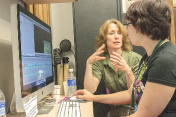Evolving Partnerships with Native American Tribes
- Gordon D. Henry
- Director, Native American Institute
- College of Agriculture and Natural Resources
- Professor, Department of English
- College of Arts and Letters
MSU's Native American Institute (NAI) has existed in one form or another for more than 30 years. It was established in 1981 as part of the newly created Urban Affairs Programs. When UAP was disbanded in 2003, the NAI became part of the College of Agriculture and Natural Resources—now with an English professor as director.
Luckily these transitions make sense to Gordon Henry, who was named to the directorship in 2010. "NAI started out as a technical assistance institute," he said. "Given the tribal economic growth, the outreach need changed. We'll always do education and health, but the tribes have some of their own people to do that now." The NAI now includes promoting public knowledge and awareness of Michigan Indian communities, history, and culture as part of its mission, as well as research, education, and policy assistance.

Institute co-director Ellen Cushman with a student.
The increasing sophistication and self sufficiency of its tribal partners gives NAI the opportunity to pursue a wider range of programming. The Institute still does a lot of the direct technical assistance work it has always done, in fields such as health, education, and sustainable development, but now the tribes are more active partners. Henry does the overall planning and coordination of these efforts, while his staff specialists lead individual projects.
Nathan Lambertson (Ojibwe, Odawa), an outreach specialist with the Institute, said that "Whenever possible, we endeavor to use a participatory/ empowerment approach. Historically the story of native peoples, as well as the direction of programs aimed at supporting those communities, has been forged and told from the outside looking in. Consistent with our roots in technical assistance, the NAI believes in helping native peoples but in ways that are mindful that the communities themselves have much to offer toward self-shaped goals and research agendas. Our role now is to be a facilitator for that."
"The purpose of these partnerships is to produce outcomes that benefit the tribal community or 'move the needle' and expand the current body of research. Projects that regard tribal leaders and members as partners, apply the tenets of community based participatory research, and include high levels of transparency, reciprocity, and consultation are more likely to produce positive results.
Mary Calcatera (Sault Ste. Marie Ojibwe)
For a small organization the Institute has a bulky portfolio. Henry named the following projects in rapid-fire succession: "We're just now getting a project off the ground with the Pokagon tribe and the ANR Product Center to assess their land for community use. We've submitted a proposal with the College of Menominee Nation to integrate new science and technology with their traditional ecological knowledge about forest management. Nathan Lambertson is designing a green development site plan with the Saginaw Chippewa Tribal College. We're doing webinars on indigenous farming and a summer event about indigenous wild foods. Mary Calcatera, our other specialist, is doing a project about school readiness. And the Gun Lake Band wants to assess damages from the Enbridge oil spill. They're working with a historian to boost their claim that they can act as trustee. We're helping them get the assessment funded."

Participants edit their videos.
Calcatera (Sault Ste. Marie Ojibwe) said that "The purpose of these partnerships is to produce outcomes that benefit the tribal community or ‘move the needle' and expand the current body of research. Projects that regard tribal leaders and members as partners, apply the tenets of community based participatory research, and include high levels of transparency, reciprocity, and consultation are more likely to produce positive results."
Many of NAI's initiatives draw on Henry's strengths as a writer and cultural scholar. "In July we did the second annual Native Youth Film Institute with Ellen Cushman (Cherokee Nation) and the Center for Applied Teaching and Learning in Arts and Humanities," he said. "Twenty-five kids produce short films. They learn about scripting, editing, music and so on. At the end we have a film festival where they showcase their work for their families and the community."
Henry is also working to bring more Native American scholars into the academy. "I'm on the organizing committee for the Native American Literature Symposium," he said. "It's the only one that's done on the reservation, in reservation communities. It covers art, history, politics, science, religion—all aspects of Native American studies."
Increasingly, NAI's projects are being powered by student interns. "We're moving toward more internships," said Henry. "They're being requested by tribes and they're good experiences for the students." Calcatera added that "The benefits for students and faculty include opportunities to learn about tribal laws, policies and issues related to a sovereign and self-determining government."
"There's a lot of communications groundwork, finding the right people for projects. You have to be in it for the long haul and build relationships."
Gordon Henry
With encouragement from the College of Agriculture and Natural Resources, the Institute plans to expand its research portfolio. "We want to do some economic development research," said Henry. "We've talked to the Michigan Economic Development Corporation about assessing the tribal influence on Michigan's economy. We're planning to write some policy papers about agricultural and food resources."
The job demands a lot of road time and follow-up, as well as persistence, flexibility, and a philosophical outlook. Although Henry, who is himself a member of the White Earth Chippewa Tribe of Minnesota, had worked in tribal communities before, he said, "It's more complex now, figuring out what we can actually do for them. We think we know what they need but they come back with something else. And we submit some stuff that doesn't fly, like a proposal on developing biofuels. The tribes liked it but it wasn't funded. We'll try again."
A year and a half into the job, Henry is already reflective about the lessons he's learned. "There's a lot of communications groundwork, finding the right people for projects," he said. "You have to be in it for the long haul and build relationships. When new leadership comes in—like me—we have to reintroduce ourselves." But, he added, "We've worked with almost all the tribes in the Lower Peninsula. We have an open invitation."
- Written by Linda Chapel Jackson, University Outreach and Engagement